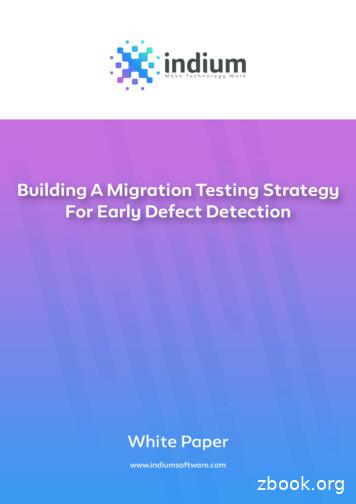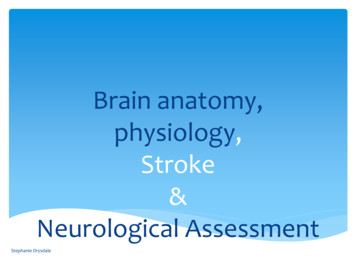Migration And Diaspora EXEGETICAL VOICES FROM
SBLPRESSMigration and DiasporaEXEGETICAL VOICES FROMNORTHEAST ASIAN WOMEN
International Voices in Biblical StudiesLPRESEditorial BoardEric Bortey AnumIda FröhlichHisako KinukawaNéstor MíguezAliou NiangNasili Vaka’utaSGeneral EditorsMonica J. MelanchthonJione HaveaSBNumber 6Migration and DiasporaEXEGETICAL VOICES FROMNORTHEAST ASIAN WOMEN
Migration and DiasporaEXEGETICAL VOICES FROMNORTHEAST ASIAN WOMENSBLPRESSEdited byHisako KinukawaSBL PressAtlanta
Copyright 2014 by SBL PressPRESLibrary of Congress Cataloging-in-Publication DataSAll rights reserved. No part of this work may be reproduced or published in print formexcept with permission from the publisher. Individuals are free to copy, distribute, andtransmit the work in whole or in part by electronic means or by means of any information or retrieval system under the following conditions: (1) they must include with thework notice of ownership of the copyright by the Society of Biblical Literature; (2) theymay not use the work for commercial purposes; and (3) they may not alter, transform,or build upon the work. Requests for permission should be addressed in writing to theRights and Permissions Office, SBL Press, 825 Houston Mill Road, Atlanta, GA 30329,USA.SBLMigration and diaspora : exegetical voices from northeast Asian women / edited byHisako Kinukawa.pages cm. — (Society of Biblical Literature international voices in biblical studies;Volume 6)Includes bibliographical references.ISBN 978-1-62837-008-9 (paper binding : alk. paper) — ISBN 978-1-62837-009-6(electronic format) — ISBN 978-1-62837-010-2 (hardcover binding : alk. paper)1. Bible—Criticism, interpretation, etc. 2. Christianity—Korea. 3. Emigration andimmigration—Religious aspects—Christianity. 4. Asia—Emigration and immigration.5. Asian diaspora. I. Kinukawa, Hisako, editor.BS511.3.M54 2014220.6—dc232014018413
CONTENTSABBREVIATIONS . viiINTRODUCTION . 1Hisako Kinukawa — Center for Feminist Theology and Ministry inJapanPostexilic Jewish Experience and Korean Multiculturalism . 3Yoon Kyung Lee — Ewha Woman’s University, Korea2.Internal Migrations and Social Justice in Amos and Micah . 19Lin Yan — Shenzhen University, People’s Republic of China3.Desiring the Empire: Reading the Book of Esther in Twenty-firstCentury Korea . . 27Yani Yoo — Methodist Theological University, Korea4.The Samaritan Woman from the Perspective of a KoreanDivorcee . 41Chanhee Heo — Seoul Women’s University, Korea5.Religious Migration and Diaspora . . .55Hisako Kinukawa — Center for Feminist Theology and Ministry inJapanPRESS1.SBLCONTRIBUTORS . 71
ABBREVIATIONSBibIntBiblical InterpretationBRevBible ReviewBTBBiblical Theology BulletinCBQCatholic Biblical QuarterlyCBRCurrents in Biblical ResearchGTJGrace Theological JournalJBLJournal of Biblical LiteratureJBQJewish Bible QuarterlyJJSJournal of Jewish StudiesJPJournal for PreachersJPCJournal of Psychology and ChristianityJQRJewish Quarterly ReviewJournal for the Study of JudaismJSOTJournal for the Study of the Old TestamentJSOTSupJournal for the Study of the Old Testament Supplement SeriesJTSPRESSJSOJListNRSVPEQRevExpTDNTListening: Journal of Religion and CultureNew Revised Standard VersionPalestine Exploration QuarterlyReview and ExpositorTheological Dictionary of the Old TestamentSBVTWBCJournal of Theology for Southern AfricaLJTSAJournal of Theological StudiesVetus TestamentumWord Bible Commentary
INTRODUCTIONHisako KinukawaSBLPRESSThe papers that comprise this volume were presented at the third meeting ofSociety of Asian Biblical Studies (SABS) held at the Sabah TheologicalSeminary, Malaysia on June 13–15, 2012 to reflect on the theme of “Migrationand Diaspora.”The five writers are women/feminist scholars from Korea, People’sRepublic of China (PRC), and Japan who locate readings of the biblical textwithin the framework of their cultures. The three countries are known asrecipients of three big world religions, namely Confucianism, Taoism andBuddhism, in addition to their native beliefs and cults. In comparison to the longhistories of these religions, Christianity arrived in these countries fairly recently.The three societies have been strongly patriarchal, even though there arevariations in the expressions of patriarchy. Women have been among thosemarginalized/despised/oppressed. Korea and PRC experienced colonization ngdiscriminated/marginalized and that of arrogance. This fact has raised sensitiveissues between Japan and the two countries.Besides being multi-religious, the three countries, influenced byglobalization, have become increasingly multicultural. We have seen more andmore immigrant workers coming as laborers. We have become more conscious ofclassism and discrimination against different and other ethnicities. Womenworkers are at the bottom of this ladder of discrimination.Women/feminist scholars in biblical hermeneutics in this region have raisedquestions against traditional, male-centered interpretations, offering distinctperspectives based on their experiences of pain, subjugation, and a forcedsacrificial philosophy of life. Through their scholarship and activism, theyattempt to conscientize women who are still fully immersed inpatriarchy/kyriarchy.The writers do not explicitly identify the methods used to interpret thebiblical text, and yet one can discern traces of literary, historical, andpostcolonial criticism in their reading of the texts.Lee Yoon Kyung studies the phenomenon of multiculturalism as it is playedout both in postexilic Judah as well as in current Korea. Beginning with asocio-political analysis of the biblical texts, and in conversation with Koreanexperience, she highlights the plight of “foreign wives” that were brought orcame from outside of Korea to marry Korean men but who are seen as the“Others” in Korean society.Lin Yan takes note of the internal migration phenomena in the huge land ofChina and then questions the activities of Amos and Micah from a similarperspective. As her title suggests, her interest is also in the execution of socialjustice in the context of migration and diaspora.
2Hisako KinukawaSBLPRESSKorean scholar Yani Yoo reads the book of Esther from the perspective ofthe narrator and his desire. She suggests that the book narrates the story of a fewelite people successful with the powers of the time. She sees the tragic ending ofthe book as a warning against the empire and human greed. Seeing some parallelsbetween the explosive developments in her country and the story, she draws ourattention to those in diaspora who have been looked down upon because of theirsocial location and ethnic difference and regarded as cheap labor.Chanhee Heo does an intertextual reading of the story of the Samaritanwoman (John 4:1–12) alongside the novel entitled My Sweet Home by Ji-YoungGong, a fellow Korean. Drawing insights from the John text she analyses themain character in the novel and showcases how the woman in the novel findsautonomy and dignity of life through her migration or diasporic experiences inlife.Hisako Kinukawa meets the Syrophoenician woman in Mark as one indiaspora and in parallel to her own Japanese religious migration and sees whattransformation the encounter brought Jesus.Though our social locations are diverse, all of us are committed to findingjustice for women in our countries and in our contemporary living through ourdialogue with biblical texts. Our struggles for survival in society and our fight fora voice and a space within a patriarchal academy are hard and painfully severe.Despite the resistance, we Asian women/feminist scholars have made efforts totransform the current situation by striving against the discrimination weencounter in our lives as women and as scholars.We hope we shed some new and distinct light from women/feminist eyesupon the interpretation of the texts on which we have chosen to reflect.
The papers that comprise this volume were presented at the third meeting of Society of Asian Biblical Studies (SABS) held at the Sabah Theological Seminary, Malaysia on June 13–15, 2012 to reflect on the theme of “Migration and Diaspora.” The five
Indian citizenship, as well as their children, who now live outside of India1) 1.4 M 2.0 M 0.3M 3.5 M2 1.0 M 1.8 M 3.0 M 0.3M INDIAN DIASPORA Definition Focus countries: UAE, UK, US, Singapore Other countries with large Indian diaspora populations Key: Number of diaspora Globally, the Indian diaspora is composed of 28.5M people
Interpreting the Wisdom Books: An Exegetical Handbook (forthcoming) Edward M. Curtis Interpreting the Psalms: An Exegetical Handbook Mark D. Futato Interpreting the Prophetic Books: An Exegetical Handbook Gary V. Smith Interpreting Apocalyptic Literature: An Exegetical Handbook Richard A. Taylor. HANDBOOKS FOR OLD TESTAMENT EXEGESIS INTERPRETING
Data Migration Planning Analysis, Solution Design and Development Mock Migration Pilot Migration Released Data Migration Active Data and User Migration Inactive Data Migration Post Migration Activities Small Bang The details for each step include: Data Migration Planing - Develop the migration strategy and approach, and define the scope,
orchestral effects, the Classic Series offers the sound, value, and flexibility that you are looking for in a small organ. SPECIFICATIONS CLASSIC SERIES 559 VOICES: 27 stops / 233 total voices 27 primary voices 81 Voice Palette voices 92 Library pipe organ voices 32 Library orchestral voices Chimes GENERAL PISTONS: 10 DIVISIONAL PISTONS: 5 .
A New Migration Testing Strategy Pre-Migration Testing The concept of pre-migration testing is not often covered during migration planning. The professionals involved in migration planning are not much aware of comprehensive pre-migration testing and the value it can add to a migration and particularly those migrations that are considered complex.
Migration overview In the context of Migration Manager, migration is the process of promoting . A migration group can be either internal or user-defined. Internal migration groups are included with the product and are linked to other logically related migration groups called dependencies. You cannot modify internal migration
Interpreting the Prophetic Books: An Exegetical Handbook Gary V. Smith Interpreting Apocalyptic Literature: An Exegetical Handbook (forthcoming) Richard A. Taylor. HANDBOOKS FOR OLD TESTAMENT EXEGESIS INTERPRETING THE PROPHETIC BOOKS An Exegetical Handbook Gary V. Smith David M. Howard Jr.
Brain anatomy, physiology, Stroke & Neurological Assessment Stephanie Drysdale. Stephanie Drysdale. Functions of the Brain FRONTAL PARIETAL OCCIPITAL Personality/Behaviour Planning Decision making Concentration Voluntary motor functions Primary motor cortex (precentral gyrus) Comprehension and language Sensory functions (pain, heat and other sensations .























